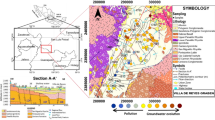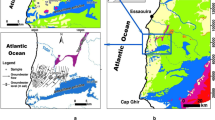Abstract
The climatic conditions of arid regions are characterized by high temperatures, low precipitation and high evapotranspiration rates that can explain the reduced recharge of aquifers. Thus, in these regions, there are some problems related to the groundwater quality and recharge that makes worse the problem of groundwater supply. A model, taking into account ternary mixtures, is presented and applied to a case study: the aquifer of San Luis Potosi valley located in the highlands of the central part of Mexico. In this valley, four hydrochemical facies were identified that correspond to the Ca–Na + K–HCO3, Na + K–Ca–HCO3, Ca–HCO3 and Ca–SO4 types. From this characterization, it was found out that the recharge area (known as Bledos Graben) is located at the SE of the valley; the deep water flow comes from there (Villa de Reyes and Alvarez Range) to the center of the valley. Mixture fractions were obtained by using chlorides and fluorides as conservative elements, from which it was possible to quantify the contribution of each member to the groundwater quality. According to these results, the contributions to the water extracted from this aquifer are as follows: shallow flows 50%, deep flows from Villa de Reyes 27%, and flows coming from the Alvarez Ranges about 15%.










Similar content being viewed by others
References
Abu-Jaber N (2001) Geochemical evolution and recharge of the shallow aquifers at Tulul al Ashiqif, NE Jordan. Environ Geol 41:372–383
Apello CA, Postma D (1996) Geochemistry, groundwater and pollution. A. A. Balkema, Rotterdam, pp 536
Carrillo JJ (2000) Application of the groundwater balance equation to indicate interbasin and vertical flow in two semi-arid drainage basins, Mexico. J Hydrol 8(5):503–520
Carrillo JJ, Clark ID, Fritz P (1992) Investigating recharge of shallow and paleo-groundwater in the Villa de Reyes Basin, SLP, Mexico, with environmental isotopes. Appl Hydrogeol 4:35–48
Carrillo JJ, Cardona A, Moss D (1996) Importance of the vertical component of groundwater flow: a hydrogeochemical approach in the valley of San Luis Potosi, Mexico. J Hydrol 185:23–44
Carrillo JJ, Cardona A, Hergt T (2001) Inducción de agua termal profunda a zonas someras: Aguascalientes, México. Rev Latinoam Hidrol 1(1):41–53
Douglas M, Clark ID, Raven K, Bottomey D (2000) Groundwater mixing dynamics at a Canadian Shield mine. J Hydrol 235:88–103
Genereux D, Wood SJ, Pringle CM (2002) Chemical tracing interbasin groundwater transfer in the lowland rainforest of Costa Rica. J Hydrol 258:163–178
Harpaz Y, Bear J (1964) Investigations on mixing of waters in underground storage operations. XIII Assembly of the IUGG, Berkeley, California, I.A.S.H., IAHS-Red Books, Publ. no.64, pp 132–153
Johannesson K, Cortés A, Ramos JA, Ramirez HA, Durazo J (2005) Geochemistry of rare earth elements in groundwaters from a rhyolite aquifer, Central México en rare earth elements in groundwater flow systems, Chap 8. Springer, Heidelberg, pp 293. ISBN 1–4020–3233–1
Laaksoharju M, Skarman C, Skarman E (1999) Multivariate mixing and mass balance (M3) calculations, a new tool for decoding hydrogeochemical information. Appl Geochem 14:861–871
Labarthe HG, Tristán GM, Aranda JJ (1982) Revisión estratigráfica del Cenozoico de la parte central del estado de San Luis Potosí, Folleto Técnico No.85, Ins. Geol. Met. UASLP, pp 208
Lee ES, Krothe NC (2001) A four-component mixing model for water in a karst terrain in south-central Indiana, USA. Using solute concentration and stable isotopes as tracers. Chem Geol 179:129–143
Mahlknecht J, Schneider JF, Merkel BJ, Navarro de Leon I, Bernasconi SM (2004) Groundwater recharge in a sedimentary basin in semi-arid Mexico. Hydrogeol J 12(5):511–530
Martinez VJ (2003) Estudio de la geologia del subsuelo del area denominada La Pila Jesús Maria, Municipio de San Luis Potosí y Villa de Reyes. Reporte Interno, Instituto Potosino de Investigación Científica y Tecnológica, A.C., pp 20, Anexos
Moise T, Starinsky EA, Katz A, Kolodony Y (2000) Ra isotopes and Rn in brines and ground waters of the Jordan–Dead Sea Rift Valley: enrichment, retardation, and mixing. Geochim Cosmochim Acta 64(14):2371–2388
Moreno CD, Campos AD, Cisneros AR (2004) Estadistica climatológica del observatório meteorológico de San Luis Potosí 1(877–2000), FI-UASLP, CIAP, pp 79
Parkhurst DL, Apello CAJ (1999) User guide to PHREEQC (version 2)—a computer program for speciation, batch reaction, one dimensional transport, and inverse geochemical calculations. U.S. Geological Survey Water Resources Invetigations Report: 99–4259
Ramos JA, Durazo J, González T, Ramírez HA, Johannesson KH, Cortés A (2005) Decay in chloride contend of ground water associated to excessive production of a well field near Leon, Mexico. Geofisica Int 44:385–390
Ravenscroft P, McArthur JM (2004) Mechanism of regional enrichment of groundwater by B: the example of Bangladesh and Michigan, USA. Appl Geochem 19:1413–1430
Rice KC, Hornberger GM (1998) Comparison of hydrochemical tracer to estimate source contributions to peak flow in a small, forest, headwater catchment. Water Resour Res 34(7):1755–1766
Skalbeck JD, Shevenell L, Widmer MC (2002) Mixing of thermal and non thermal waters in the Steamboat Hills Area, Nevada, USA. Geothermics 31:60–90
Valentino GM, Stanzione D (2002) Source process of the thermal waters from the Phlegraean Fields (Naples, Italy) by means of selected minor and trace elements distribution. Chem Geol 245:245–274
Wallick EI (1981) Chemical evolution of groundwater in a drainage basin of Holocene Age, East-Central Alberta, Canada. J Hydrol 54:245–283
Acknowledgments
The authors would like to thank Professor Brent Handy, from the Faculty of Chemistry of the UASLP, for his comments on the orthography of this manuscript. Thanks are also expressed to anonymous referees and to J. Lucero Hernandez Martinez for her contribution.
Author information
Authors and Affiliations
Corresponding author
Rights and permissions
About this article
Cite this article
Ramos-Leal, J.A., Martínez-Ruiz, V.J., Rangel-Mendez, J.R. et al. Hydrogeological and mixing process of waters in aquifers in arid regions: a case study in San Luis Potosi Valley, Mexico. Environ Geol 53, 325–337 (2007). https://doi.org/10.1007/s00254-007-0648-3
Received:
Accepted:
Published:
Issue Date:
DOI: https://doi.org/10.1007/s00254-007-0648-3




